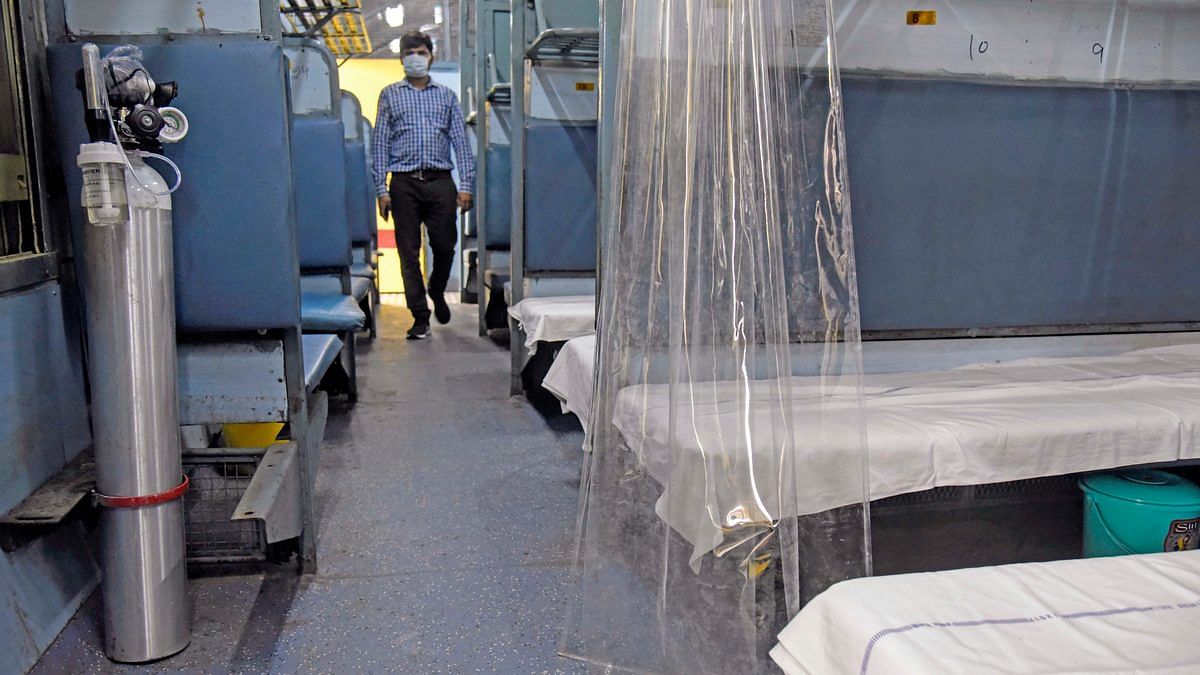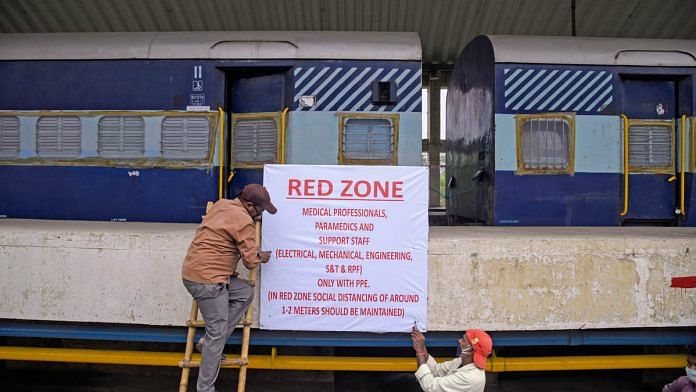New Delhi: The Indian Railways Monday deployed 54 isolation coaches at Delhi’s Shakurbasti railway station maintenance depot — a number that will be eventually scaled up to 500.
The move came a day after Union Home Minister Amit Shah said on Twitter that in view of the shortage of beds for Covid-19 patients in the national capital, the Centre would provide 500 railway coaches, boosting the city’s capacity by 8,000 beds.
According to an assessment made by the central government last week, Delhi, which has the third-highest number of cases, may already have all its ICU beds occupied, with cases only expected to rise in the next few weeks.
Last week, Delhi Deputy Chief Minister Manish Sisodia had said that the national capital could have over five lakh Covid-19 cases by the end of July, and there would be a need for 80,000 additional beds to accommodate the infected patients.
ThePrint explains how the railways’ isolation coaches could help with this situation, what are the logistics involved, and where will the railways get the manpower to intervene in this medical emergency.
Also read: To cut costs, Indian Railways to axe thousands of retired staff it had re-hired
The idea of isolation coaches
Hours into the lockdown due to the Covid-19 pandemic in March, Prime Minister Narendra Modi called for railway coaches and cabins to be converted into isolation wards or ICUs to ensure healthcare access in remote areas.
It was felt that since virtually all towns have rail access, trains with makeshift isolation wards will help serve areas that experience an outbreak but lack the requisite facilities.
According to the health ministry, isolation coaches, or ‘Covid Care Centres’, are meant “to observe the patients as mentioned in scope for their symptoms and clinical”, and “in case of change of the symptoms/clinical conditions, suitable reference to the designated centre/hospital for further management”.
While the isolation coaches are meant to augment the country’s existing health infrastructure, railways officials say they are best used for mild Covid cases. The health ministry document too states that railway coaches are to be used for cases that can be categorised into “mild” or “very mild”.
Over two months later, there were no takers for the Indian Railways’ unique facility, and it was decided that 60 per cent of the isolation coaches would be reconverted. But in the last one week, three governments — Delhi, Telangana and Uttar Pradesh — have requested coaches from the railways, in the light of increasing cases and limited health facilities.
According to official figures, the railways spent Rs 77,678 on converting each coach into an isolation ward. Given that the railways have converted a total of 5,000 coaches, the exercise is estimated to have cost about Rs 39 crore.
Also read: Rail coach as ICU — how Modi govt plans to beat healthcare gaps in remote areas
Inside an isolation coach
Eight coupes in each non-AC coach have been converted into isolation wards, and each coupe can accommodate two patients each. Middle berths have been removed from all isolation coaches.

Two of the four toilets in each coach have been converted into bathing rooms. One coupe in each coach is reserved for paramedic staff.
All the coaches have oxygen cylinders in each coupe. Some have ventilators, and it is the responsibility of the railways to ensure their availability on each coach.
Other items like bottle holders, dustbins, mugs, buckets, linen, transparent plastic curtains, electrical points, etc. are also supposed to be arranged by the railways.
According to the health ministry document cited above: “The state government shall map at least one Covid-dedicated hospital for each train so that patient can be shifted to the hospital in case of emergency. The state/UT government shall make suitable ambulance arrangements for shifting the patient — preferably one basic life support ambulance with oxygen and ambubag should be stationed at the railway station where the train is placed.”
There’s also a provision to keep suspected Covid patients away from those who are confirmed to have the infection.
Also read: ‘Lost’ trains, dead passengers — Railways blames ‘extraordinary times’ for Shramik train mess
How do the coaches work?
State-wise nodal officers have been designated by the railways for allocation of trains, and for coordinating with the respective state/UT governments. States and UTs have also designated nodal officers for coordination with the railways, specifically for isolation coaches.
States and UTs send their requirements through these sets of nodal officers, after which the railways allocate these coaches.
“After the allocation by the railways, the train shall be placed at required station with necessary infrastructure, and handed over to district collector/district magistrate or one of their authorised persons,” the health ministry guidelines state.
“The staff deployed on the special train coaches would work under the overall supervision of the chief medical and health officer (CMHO) of the district concerned, or the nodal officer identified by the respective district collector/magistrate,” they add.
A railways official explained that eventually, when the infrastructure has been provided and the coach has been stationed, the state/union territory government becomes the deciding authority.
“The doctors and medical staff are to be provided by the state and district authorities, and they will take all the crucial decisions,” the official said.
However, the railways continue to be responsible for making arrangements for cleaning, repairs, replenishment of chlorine tablets at the bio-toilet discharge, providing proper electricity connections and maintenance of electric installations, catering arrangements through IRCTC or the commercial department, as well as ensuring suitable security for the coaches, patients and staff working by the Railway Protection Force.
Stations earmarked
The railways have set aside a list of 215 stations across the country where the special train coaches can be placed. These stations have been selected “as allied facilities to make these coaches operational”, since water and electricity may not be available at all stations.
In Delhi, for example, the railways said no trains would be run from Anand Vihar station beginning Monday; instead, all platforms would be used to deploy isolation coaches for coronavirus patients.
Also read: A train of afterthoughts: How Indian Railways itself became the story in a lockdown



